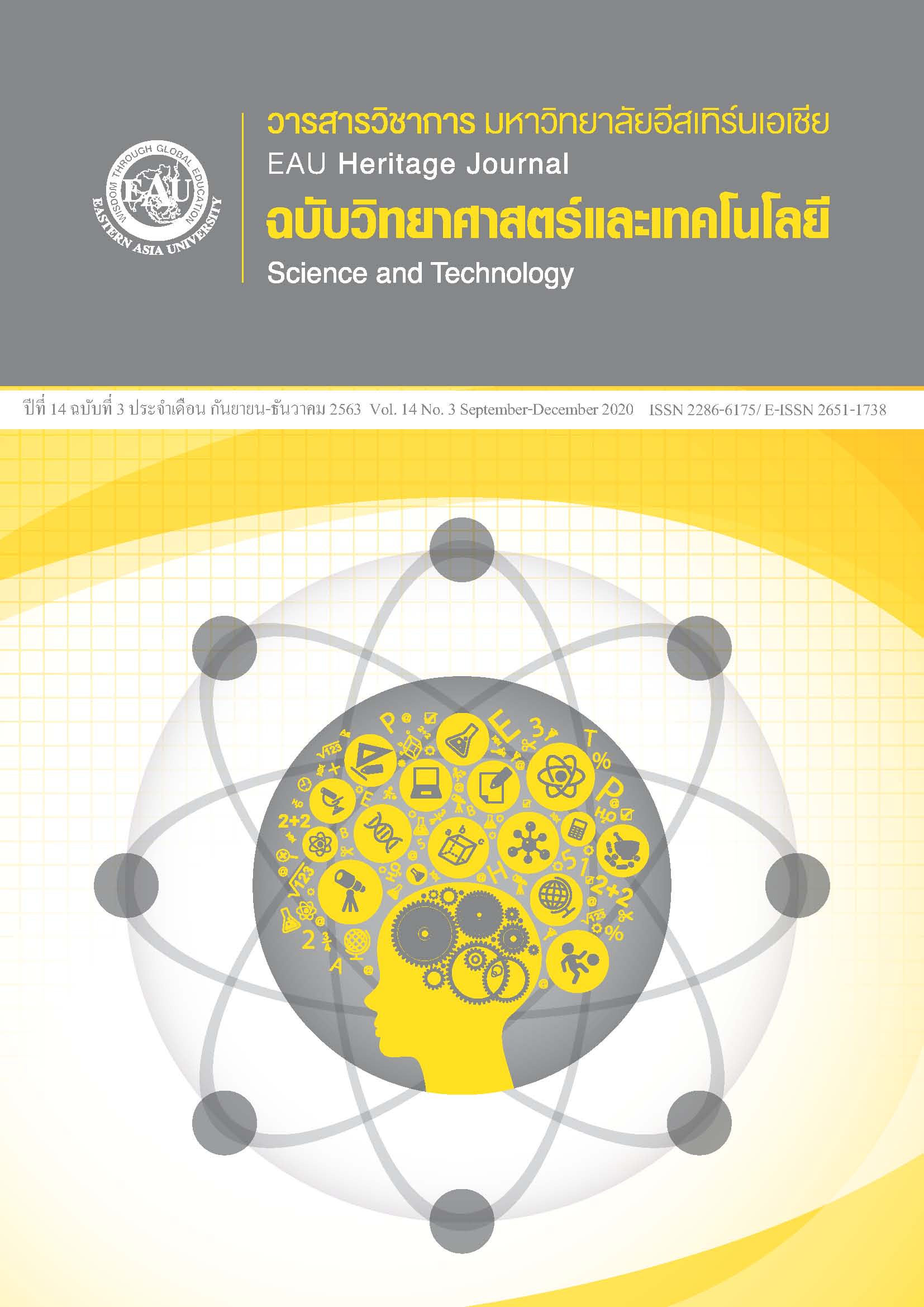ผลกระทบของการพัฒนานาโนเทคโนโลยีต่อสิ่งแวดล้อมและสุขภาพ
คำสำคัญ:
นาโนเทคโนโลยี, อนุภาคนาโนเชิงวิศวกรรม, ผลกระทบต่อสิ่งแวดล้อม, ผลกระทบต่อสุขภาพบทคัดย่อ
ด้วยคุณสมบัติที่โดดเด่นของนาโนเทคโนโลยี จึงถูกนำมาใช้ในรูปของอนุภาคนาโนเชิงวิศวกรรมกับอุตสาหกรรมต่าง ๆ เพื่อเพิ่มมูลค่าให้กับผลิตภัณฑ์ ทำให้เกิดความก้าวหน้าทางเศรษฐกิจ รวมทั้งการจ้างงานเพื่อเพิ่มการผลิตสินค้าให้ตอบสนองต่อความต้องการสินค้า จนเกิดผลกระทบต่อสิ่งแวดล้อม ที่สังเกตได้จากมีการตรวจพบอนุภาคนาโนในธรรมชาติ แน่นอนว่าสิ่งมีชีวิตที่อาศัยในสิ่งแวดล้อมย่อมหลีกเลี่ยงการสัมผัสอนุภาคนาโนเชิงวิศวกรรมไม่ได้อย่างแน่นอน ซึ่งนักวิจัยได้พยายามศึกษาความเป็นพิษขออนุภาคนาโนชนิดต่าง ๆ โดยใช้พืช สัตว์และเซลล์มนุษย์ในการทดลอง พบว่าอนุภาคนาโนที่อยู่ในสภาวะที่เหมาะสม จะสามารถสร้างความเป็นพิษได้หลายรูปแบบ เช่น ยับยั้งการเจริญเติบโตในพืช การทำลายสารพันธุกรรมในสัตว์ทดลองและเซลล์มนุษย์ รวมทั้งเป็นสาเหตุของการเกิดเนื้องอกหรือเซลล์มะเร็งได้ ยิ่งไปกว่านั้น จากการทบทวนผลการศึกษาเกี่ยวกับผลจากการได้รับสัมผัสอนุภาคนาโนที่ผ่านมา พบว่าผลการศึกษาส่วนใหญ่ได้ศึกษาในพืชและสัตว์ทดลองแสดงให้เห็นว่าการได้รับสัมผัสอนุภาคนาโนมีความอันตรายต่อสิ่งมีชีวิต แต่อย่างไรก็ตามนาโนเทคโนโลยีถือว่าเป็นเทคโนโลยีเกิดใหม่ ต้องมีการศึกษาผลกระทบต่อสิ่งแวดล้อมและสุขภาพอีกมาก รวมทั้งการศึกษาการได้รับสัมผัสระยะยาว ซึ่งจะช่วยให้ได้ข้อสรุปที่ชัดเจนว่าการได้รับสัมผัสอนุภาคนาโนเชิงวิศวกรรมมีความรุนแรงต่อมนุษย์อย่างไร อีกทั้งเป็นการนำไปสู่การออกแบบข้อบังคับและวิธีการต่าง ๆ ในการลดผลกระทบจากนาโนเทคโนโลยีต่อสิ่งแวดล้อมและสุขภาพได้
เอกสารอ้างอิง
Ab, A., Hussain, M., Suman, V. B., & Khalid, P. (2016). Toxicology of Carbon Nanotubes-A review. International Journal of Applied Engineering Research, 11(1), 148-157. https://pdfs.semanticscholar.org/1a41/b8d22802b1f2bc79b471a9bac5432464e41a.pdf
Becker, H., Herzberg, F., Schulte, A., & Kolossa-Gehring, M. (2011). The carcinogenic potential of nanomaterials, their release from products and options for regulating them. International Journal of Hygiene and Environmental Health, 214(3), 231–238. https://doi.org/10.1016/j.ijheh.2010.11.004
British Standard Institute (BSI). (2007). PD 6699-2 Nanotechnologies-part2: Guide to safe handling and disposal of manufactured. Retrieved from https://ethics.iit.edu/NanoEthicsBank/node/28
Chen, X., Wang, R., Lutsey, P. L., Zee, P. C., Javaheri, S., Alcántara, C., Jackson, C. L., Szklo, M., Punjabi, N., Redline, S., & Williams, M. A. (2016). Racial/ethnic differences in the associations between obesity measures and severity of sleep-disordered breathing: The multi-ethnic study of atherosclerosis. Sleep Medicine, 26(1), 46–53. https://doi.org/10.1016/j.sleep.2015.06.003
Das, B., KumarDash, S. K., Mandal, D., Ghosh, T., Chattopadhyay, S., Tripathy, S., Das, S., Sankar KumarDey, S. K., Das, D., & Roy, S. (2017). Green synthesized silver nanoparticles destroy multidrug resistant bacteria via reactive Oxygen species mediated membrane damage. Arabian Journal of Chemistry, 10(6), 862-876. https://doi.org/10.1016/j.arabjc.2015.08.008.
Department of Industrial Works. (2012). Nanosafety guideline for industries. Bangkok: Chokun copies. (in Thai)
Department of Labour Protection and Welfare. (2011). Nanosafety. Retrieved from http://www.oshthai.org/attachments/article/146/146.pdf (in Thai)
European Commission (EC). (2011). Recommendation on the definition of a nanomaterial. Retrieved from http://data.europa.eu/eli/reco/2011/696/oj.
Fede, C., Fortunati, I., Weber, V., Rossetto, N., Bertasi, F., Petrelli, L., Guidolin, D., Signorini, R., De Caro, R., Albertin, G., & Ferrante, C. (2015). Evaluation of gold nanoparticles toxicity towards human endothelial cells under static and flow conditions. Microvascular Research, 97(1), 147–155. https://doi.org/10.1016/j.mvr.2014.10.010
Food and Drug Administration. (2015). Guidance for industry on nano health products. Nonthaburi: Food and Drug Administration. (in Thai)
Ghosh, M., Bandyopadhyay, M., & Mukherjee, A. (2010). Genotoxicity of Titanium Dioxide (TiO2) nanoparticles at two trophic levels: Plant and human lymphocytes. Chemosphere, 81(10), 1253–1262. https://doi.org/10.1016/j.chemosphere.2010.09.022
Harper, S., Wohlleben, W., Doa, M., Nowack, B., Clancy, S., Canady, R., & Maynard, A. (2015). Measuring nanomaterial release from Carbon Nanotube Composites: Review of the state of the science. Journal of Physics: Conference Series, 617(1), 012026. doi: 10.1088/1742-6596/617/1/012026
Institute for Innovation & Development of Learning Process. (2006). Nanotechnology. Retrieved from https://il.mahidol.ac.th/e-media/nano/Page/main.html. (In Thai)
Institute for Occupational Safety and Health of the German (IFA). (2011). Criteria for assessment of the effectiveness of protective measures. Retrieved from https://www.dguv.de/ifa/fachinfos/nanopartikel-am-arbeitsplatz/beurteilung-von-schutzmassnahmen/index-2.jsp
Koivisto A.J., Jensen A.C.Ø., Kling K.I., Nørgaard A., Brinch A., Christensen F., & Jensen, K.A. (2017). Quantitative material releases from products and articles containing manufactured nanomaterials: Towards a release library. NanoImpact, 5(1), 119-32. https://doi.org/10.1016/j.impact.2017.02.001.
Lin, D., & Xing, B. (2007). Phytotoxicity of nanoparticles: Inhibition of seed germination and root growth. Environmental Pollution (Barking Essex: 1987), 150(2), 243–250. https://doi.org/10.1016/j.envpol.2007.01.016
Ma, J., Mercer, R. R., Barger, M., Schwegler-Berry, D., Cohen, J. M., Demokritou, P., & Castranova, V. (2015). Effects of amorphous silica coating on Cerium Oxide nanoparticles induced pulmonary responses. Toxicology and Applied Pharmacology, 288(1), 63–73. https://doi.org/10.1016/j.taap.2015.07.012
Meldrum, K., Guo, C., Marczylo, E. L., Gant, T. W., Smith, R., & Leonard, M. O. (2017). Mechanistic insight into the impact of nanomaterials on asthma and allergic airway disease. Particle and Fibre Toxicology, 14(1), 45-53. https://doi.org/10.1186/s12989-017-0228-y
National Institute for Occupational Safety and Health (NIOSH). (2013). Occupational exposure to Carbon Nanotubes and Nanofibres. Retrieved from https://www.cdc.gov/niosh/docs/2013-145/pdfs/2013-145.pdf
Nguyen, K. C., Rippstein, P., Tayabali, A. F., & Willmore, W. G. (2015). Mitochondrial toxicity of Cadmium Telluride Quantum dot nanoparticles in Mammalian Hepatocytes. Toxicological Sciences: An official journal of the Society of Toxicology, 146(1), 31–42. https://doi.org/10.1093/toxsci/kfv068
Organization for Economic Co-operation and Development (OECD). (2016). Categorization of manufactured nanomaterials. Retrieved from http://go.nature.com/2uQY5lS
RNCOS E-services Pvt. Ltd. (2015). Nanotechnology market outlook 2020. Retrieved from http://www.imea.com.br/site/upload/pdf/arquivos/AgroMT_Outlook_2022_(Ingles).pdf
Rodrigues, S. M., Demokritou, P., Dokoozlian, N., Hendren, C. O., Karn, B., Mauter, M. S., Sadik, O. A., Safarpour, M., Unrine, J. M., Viers, J., Welle, P., White, J. C., Mark R. Wiesnerde, M. R., & Lowry, G. V. (2017). Nanotechnology for sustainable food production: Promising opportunities and scientific challenges. Environmental Science: Nano, 4(4), 767-781. https://doi.org/10.1039/C6EN00573J
Roco, M. C., Mirkin, C. A., & Hersam, M. C. (2011). Nanotechnology research directions for societal needs in 2020. Boston: Springer.
Schulte, P. A., Kuempel, E. D., & Drew, N. M. (2018). Characterizing risk assessments for the development of occupational exposure limits for engineered nanomaterials. Regulatory Toxicology and Pharmacology: RTP, 95(1), 207–219. https://doi.org/10.1016/j.yrtph.2018.03.018
Shapira, P., & Wang, J. (2010). Follow the money. Nature, 468, 627–628. https://doi.org/10.1038/468627a
Shi, X., Li, Z., Chen, W., Qiang, L., Xia, J., Chen, M., Zhu, L., & Alvarez, P. J. J. (2016). Fate of TiO2 nanoparticles entering sewage treatment plants and bioaccumulation in fish in the receiving streams. Nano Impact, 3-4(1), 96-103. http://dx.doi.org/10.1016/j.impact.2016.09.002
U.S. Environmental Protection Agency (USEPA). (2017). Reviewing new chemicals under the Toxic Substances Control Act (TSCA): Control of nanoscale materials under the Toxic Substances Control Act. Retrieved from https://www.epa.gov/reviewing-new-chemicals-under-toxic-substances-control-act-tsca/fact-sheet-nanoscale-materials
Wang, P., Lombi, E., Sun, S., Scheckel, K. G., Malysheva, A., McKenna, B. A., Menzies, N. W., Fang-Jie Zhao, F., & Kopittke, P. M. (2017). Characterizing the uptake, accumulation and toxicity of Silver Sulfide nanoparticles in plants. Environmental Science: Nano, 4(2), 448-460. https://doi.org/10.1039/C6EN00489J
Zou, Y., Wang, X., Khan, A., Wang, P., Liu, Y., Alsaedi, A., Hayat, T., & Wang, X. (2016). Environmental remediation and application of Nanoscale Zero-Valent Iron and its composites for the removal of heavy metal ions: A review. Environmental Science & Technology, 50(14), 7290-7304. https://doi.org/10.1021/acs.est.6b01897







